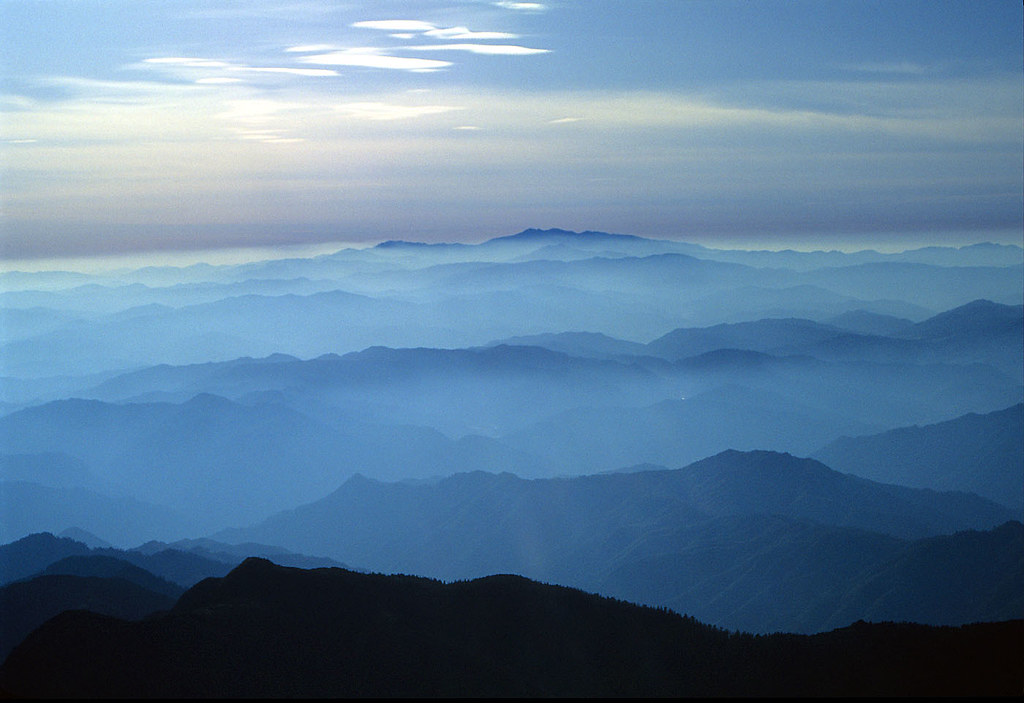In the old days, a “meizan” was an attractively shaped mountain that loomed over one of the main highways. By “attractively shaped”, I mean that people of that era favoured regularly shaped mountains, like Mt Fuji, as they had yet to discover the beauty that resides in deformity. In those days, scarcely any mountains of the future Japan Alps made it onto the honour roll of notable mountains, because they were either too remote from civilisation or too uncouthly shaped. One of the few exceptions was Ariake-yama.
 |
| Ariake-yama and its triple-crowned summit (Wikipedia) |
Today, rather few people know Ariake-yama. Of those who do, not many pay the mountain much regard. And, although the ridgeways between Yari-ga-take and Tsubakuro may be crowded enough to qualify as an Alpine “Ginza”, fewer still pay much attention to Ariake-yama even when they find it rearing up at them on their way to the foot of Tsubakuro. Rather, their eyes are drawn to the more imposing heights beyond. Ariake, it seems, has been consigned to the meizan of past ages.
In former times, though, people would direct their gaze not to those indistinct higher peaks but to the shapely mountain right in front of them, revering Ariake-yama as the Mt Fuji of Shinano Province. In an age when the Northern Alps were still “terra incognita”, Ariake was celebrated by no less a poet than Monk Saigyō:
In Shinano on a day
It sent me awestruck on the way
To Hosono, the sight
Of mighty Ariake on the right
And then there are these lines by Monk Yūgyō:
By this moon’s kindly light
I will not lose the narrow
Road to Hosono, although
It leads me under Ariake’s height
 |
| Ariake-yama seen from Otensho-dake; print by Yoshida Hiroshi |
According to an old chronicle, the mountain was opened in the second year of Daidō (807), when the great avatar Tohanachi Gongen was enshrined there at a place sacred to Ame-no-Uzume, where this goddess of dawn, mirth and revelry had manifested herself as a Buddha to save all living things. The mountain was once called Tohanachi-dake or “Door Away Peak”, in honour of the legend in which the sun goddess Amaterasu shut herself up in a cave and was coaxed out again when the goddess Ame-no-Uzume performed a comical dance. At which the god Tajikarawo-no-mikoto wrenched away the cave’s door and hurled it to earth at this very spot.
I came across this chronicle, the Record of Ariake’s Inauguration (Ariake Kaizan Ryakki), in Mr Kumahara Masao’s book on the dawn of Japanese mountaineering. By this account, the mountain mystic Yūkai, finding it lamentable that people had altogether given up climbing this sacred mountain, set out with his youngest brother in the sixth year of Kyōho (1721) together with fifteen or so villagers from the hamlet of Itadori at the mountain’s foot, and found his way over trackless slopes to the summit. There they stayed overnight and descended the next day.
The first path up the mountain was presumably opened on this occasion, as the chronicle says. And after a small shrine was installed on the summit, people came every summer, from far and wide, in droves to climb the mountain.
For evidence that this custom lasted into the Meiji period, we need look no further than Walter Weston, the mountaineering missionary and so-called Father of the Japan Alps, who climbed Ariake on August 14, 1912, in the first year of Taishō. Presumably he’d heard of Ariake’s reputation as a “meizan” of long standing. Most people associate Weston with Mountaineering and Exploration in the Japanese Alps (1896), and rather fewer are aware of his later book, The Playground of the Far East (1918), which also concerns itself mainly with the mountains of Japan. This is probably because there is no translation. It is in this later book that he describes his ascent of Ariake.
Weston came to Nakabusa-onsen with the intention of climbing Ariake and Tsubaruko-dake. He was accompanied to the hot spring village by the guide Nemoto Seizō, with whom he’d climbed Myōgi, but set out for the mountain with the landlord of his inn too, as well as three more people; a journalist, a photographer and an artist who happened to be staying there.
The artist, as I learned only a few years ago, was none other than Ishida Ginshō, who is still alive and well in Kiso. From the sketchbook that Mr Ishida took with him on the Ariake climb, and still has in his possession, we see that there was a proper shrine on the summit and that, just beside it, Weston and his companions stretched themselves out on a rock to rest. According to Ishida, Weston was a real gentleman and chanted the mountain pilgrim’s traditional refrain, rokkon shōjō (may the six senses be purified) as they climbed.
In his book, Weston records that they reached the summit in less than three hours, walking up a forested path to reach a summit “bellevue of unusual interest”. As we’ve noted, Ariake was one of the first mountains in the Northern Japan Alps to be opened. Yet it has since so far fallen out of favour with the times that it hardly features even in guidebooks. I’ve heard too that the path has become horribly overgrown. When seen to best advantage, though, from somewhere due eastwards along the Takase River, the summit appears to wear a triple crown and elegantly trails its ridges to right and left. And then it’s easy to understand how Ariake came by its title of Shinano-Fuji.
References
Ohmori Hisao, Yama no tabi, Hon no tabi (A journey in mountains and books), Heibonsha 2007.
Fukada Kyūya, Hyakumeizan igai no 50 meizan (百名山以外の名山50), Kawade Shobō Shinsha.
See previous post for the story of how this essay was dropped when the original Hyakumeizan series was republished in book form. But why was it dropped? History does not, it seems, relate. You decide...






